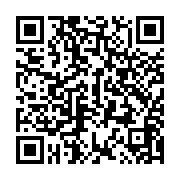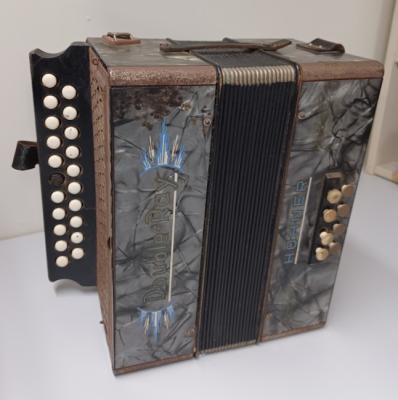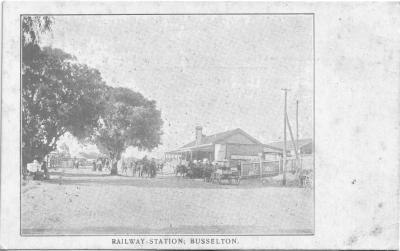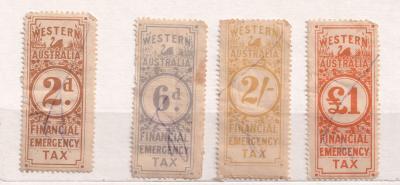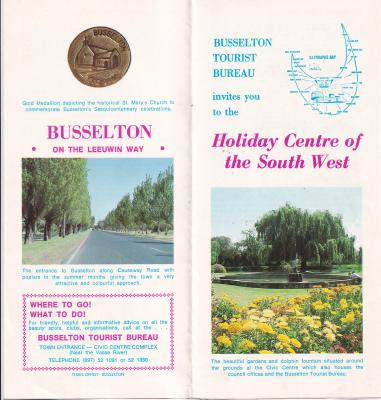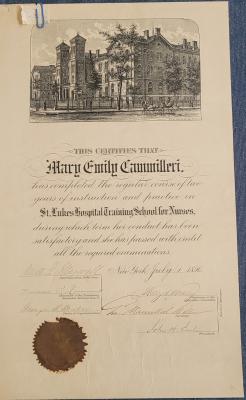Hohner Double Ray Delux Button Accordion
c. 1930This is a Hohner Double Ray Deluxe black dot diatonic button accordion that was made in Germany in the 1930s. It is made of a black moulded plastic with stiffened 20 fold fabric bellows. It has has a 2 row treble keyboard with 21 buttons (including the ubiquitous Hohner black dot) and 12 bass buttons. There is a metallic grill above above flyscreen netting that protect the reeds on the treble side. There are leather straps that are used to keep the accordion bellows in the closed position and a leather strap that is used by the player to support the instrument.
Austrian inventor, Cyril Demian, patented the first diatonic button accordion in 1829, the same year Charles Wheatstone made the first concertina. The name 'Accordion' is thought to originate from the German word for chord “Akkord”. The button accordion was first mass-produced in Europe in 1835 and whilst not cheap it was the first mass-produced, durable, portable instrument. At first, the button accordion was too expensive to be popular with the lower and middle classes but this changed as it became cheaper in the 1860s. Surviving early instruments show that they only played chords, were played left-handed and had only 5 buttons (10 chords) indicating they were mostly used for accompaniment.
The Hohner Company was founded by Matthias Hohner in Trossingen, Germany in 1857 and became a market leader in harmonicas and accordions. Hohner is still active in this market in the 2020s.
Details
Details
On the front of the treble side the following has been embossed into the plastic body
Double-Ray
DE LUXE
On the front of the base side on the left
Black Dot
(black dot logo)
Double Ray
(the Double Ray swastika like logo)
On the front of the base side above the buttons
HOHNER
On the front of the base side on the right
Black Dot
(black dot logo)
Double Ray
(the Double Ray swastika like logo)
A button accordion is a type of accordion which has buttons rather than a piano style keyboard and they are particularly common in European countries and countries where European people settled.
A Melodeon or diatonic button accordion is a member of the reed free aerophone family of instruments. The melody-side keyboard (treble) has one or more rows of buttons, with each row producing the notes of a single diatonic scale. Pushing or pulling the bellows slower or faster makes the sound softer or louder, respectively. The accordion has free reeds on both the treble and bass sides. The press of a button opens a valve to allow air to pass through the reeds to make a sound when the bellows are pumped in or out. In the diatonic button accordion, reeds are fixed in pairs so that one note sounds when air moves in, and a different one when air moves out. The button accordion has melodic (treble) notes on one side of the bellows (usually the right side), and bass accompaniment notes on the other side (generally the left).
This accordion was owned by J Rutherford.
More items like this
Other items from Busselton Historical Society
- Zither
- Violin
- "Stainer" Violin
- Postcard - Railway Station, Busselton
- Autoharp / Chorded Zither
- Busselton Brass Band - Bass Drum
- Western Australia Duty & Tax Stamps Collection
- Tourism Brochures - Busselton
- Souvenir Ribbon - Busselton Bypass 2000
- Certificates - Mary Cammilleri Wood
- Music Lyre
- Postcard - Queen Street, Busselton
Scan this QR code to open this page on your phone ->
